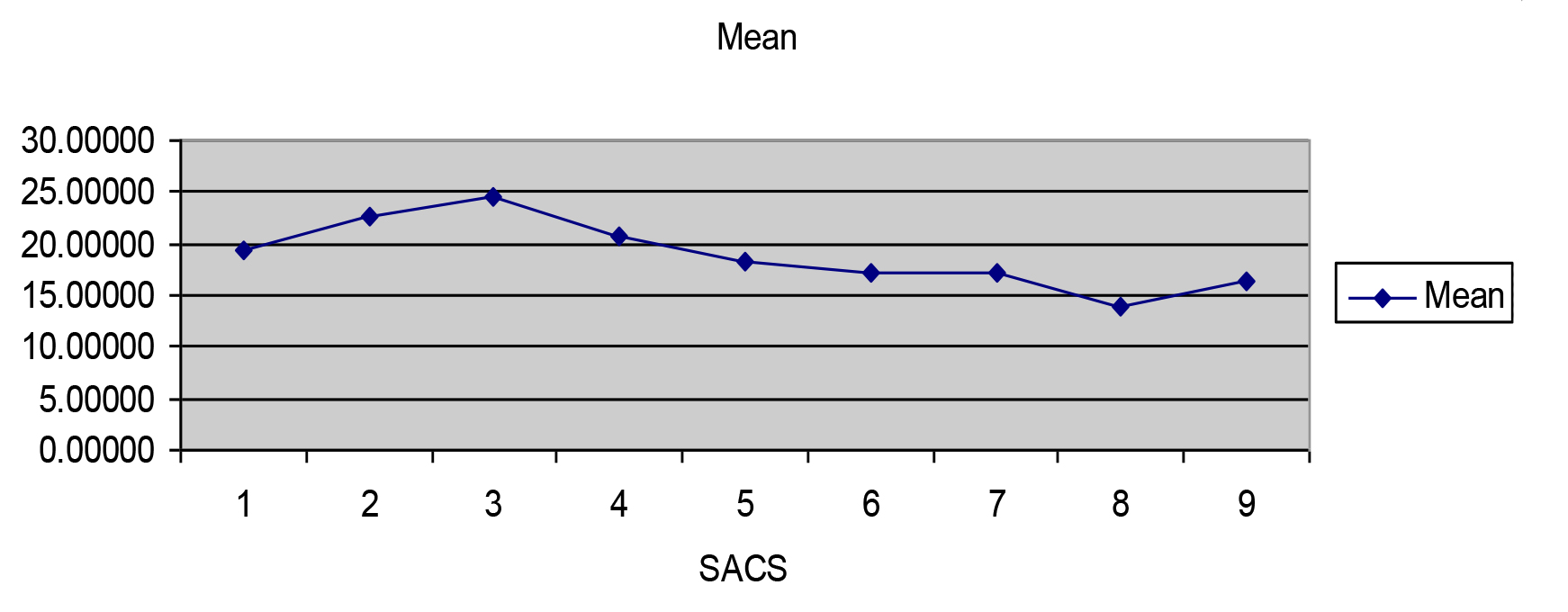Students' stress tolerance rating by modern psychological test methods
Фотографии:
ˑ:
O.N. Deberdeeva1
Dr.Sc.Econ., Professor M.V. Polevaya2
Dr.Biol., Professor Т.V. Tarasova3
PhD, Associate Professor R.S. Tarasov3
1Plekhanov Russian University of Economics, Moscow
2Financial University under the Government of the Russian Federation, Moscow
3N.P. Ogarev Mordovia State University, Saransk
Keywords: stress, mental stress, coping strategies, coping behaviour, stress effects.
Introduction. Learning activity of modern students is inextricably linked to stresses. "Stress is a body condition characterized by the discrepancy between its ability to adequately meet the environmental requirements and the requirement level" [1, 2].
In recent years, scientists have emphasized the conventionality of dichotomy between physiological and mental stresses. There are always mental elements in physiological stress and vice versa. Students, like anyone else, overcome stresses in different ways [3, 5]. However, coping strategies used by students are to be socially acceptable and successful, since their learning activity, in addition to training, is also aimed at assimilating the content area and activity methods, development of the activity subject itself, its inclusion into the system of public relations and open team work [4, 6]. Behaviour that is aimed to deal with stresses, or, in other words, coping, means mastering, adaptive behaviour in order to restore the psychological balance [9, 12]. Huge amount of work on the restoration and maintenance of physical and mental health is being carried out by teachers of the Physical Education Department and Psychology Department of Plekhanov Russian University of Economics. During the lessons, teachers of these departments pay considerable attention to both physical and mental health of the students. Various measures aimed at promoting a healthy lifestyle are taken at university from time to time. Thus, the Physical Education Department held the annual Student Research and Practical Conference "Sports Science". During the conference, they worked out the mechanisms of realization of the efforts to overcome stresses, based on the processes of cognitive evaluation of both the situation itself and students’ personal resources. The main conclusion drawn from the conference concerned the degree of controllability of this or that situation by the subject, and the possibility of using a certain coping strategy in a difficult situation.
Methods and structure of the study. The issue of the impact of coping strategies on students’ progress in studies remains understudied. Thus, for instance, it cannot be clearly and conclusively stated that the use of effective coping strategies leads to overachievements in the learning activity, nor can it be said that the use of ineffective coping strategies will reduce the effectiveness of students’ learning and cognitive activities [7, 10]. Accordingly, the objective of the study was to analyze students’ stress tolerance, their strategies of coping with academic stress using modern psychological test methods.
The study involved first-to-third-year students of Plekhanov Russian University of Economics, Moscow, majoring in "Sport Industry Management" at the Faculty of Hotel, Restaurant, Tourism and Sport Industry and "Organizational psychology" at the Faculty of Management. They participated in the study on a voluntary basis. The sample was made of 21 subjects, including 3 males and 19 females. The subjects’ academic stress coping abilities were tested by the Hobfoll’s Strategic Approach to Coping Scale (SACS) method adapted by N. Vodopyanov and Y. Starchenkov. The method is used to study behavioral strategies and models of overcoming behaviour. Overcoming is deemed to be a stabilizing factor that can help people maintain their psychosocial adaptation during stress periods. The questionnaire was proposed by S. Hobfoll and was based on the multiaxial model of "coping behaviour". The proposed model has two main axes: prosocial - asocial, active - passive and one additional axis: direct - indirect. These axes present the measurements of common coping strategies that are divided into behaviour patterns. In general, the questionnaire estimates 9 behaviour patterns (active behaviour strategy - assertive actions; prosocial behaviour strategy - making social contacts, seeking social support; passive behaviour strategy - cautious actions, avoidance; direct behaviour strategy - impulsive actions; indirect behaviour strategy - manipulative actions; asocial behaviour strategy - asocial actions, aggressive actions [8, 11]. Moreover, the strategies are divided into three groups by efficiency in adaptation to professional stress: effective strategies - assertive actions, seeking social support, making social contacts; intermediate group of strategies - cautious actions, impulsive actions; inefficient strategies - avoidance, manipulative actions, aggressive actions, asocial behavior.
General characteristics of coping strategies used by students in stressful situations.
The analysis of coping strategies by the SACS method revealed the following with the main descriptive statistics presented in the diagram and Table 1.

Figure 1. Coping strategies averages.
Table 1. Mean, minimum, maximum, standard deviation by SACS method.
Variable |
Descriptive Statistics (Spreadsheet2) |
||||
Valid N |
Mean |
Minimum |
Maximum |
Std.Dev. |
|
SACS1 |
21 |
19.47619 |
13.00000 |
26.00000 |
3.682649 |
SACS2 |
21 |
22.71429 |
15.00000 |
28.00000 |
3.494894 |
SACS3 |
21 |
24.61905 |
15.00000 |
30.00000 |
3.930346 |
SACS4 |
21 |
20.71429 |
11.00000 |
29.00000 |
3.796615 |
SACS5 |
21 |
18.38095 |
10.00000 |
25.00000 |
3.323796 |
SACS6 |
21 |
17.23810 |
9.00000 |
24.00000 |
4.403462 |
SACS7 |
21 |
17.23810 |
9.00000 |
23.00000 |
3.477136 |
SACS8 |
21 |
13.95238 |
7.00000 |
22.00000 |
3.338805 |
SACS9 |
21 |
16.38095 |
9.00000 |
26.00000 |
4.212792 |
As seen from the diagram, it is prosocial behaviour strategies that generally dominate in the group of subjects under stress: making social contacts (SACS2) and seeking social support (SACS 3). The least characteristic strategy was asocial behaviour (SACS 8).
The analysis of the coping behaviour features revealed that the prosocial behaviour strategies dominated in the group of interviewed students: making social contacts and seeking social support, which is associated with social orientation of their future profession. Asocial behaviour was least typical of the respondents. Most likely, this is due to the ideas students have about how a future specialist in psychology and sports should behave. According to the prevailing opinion, due to their social orientation both psychologists and athletes cannot behave asocially, demonstrate their power or exceed their authority, putting their own interests above those of their colleagues, clients, etc.
So, according to the findings, it is possible to develop some practical recommendations for teachers and students: one should continue and take further actions to form effective strategies of coping with academic and, as a result, future professional stresses through constant and systematic promotion of both physical and mental health. Psychology and sports students should learn how to cope with difficult situations on their own and regularly. Teamwork to solve complex educational problems will be effective as well, but at the same time everyone should be actively involved in the process, not shift his responsibility and consider his fellow students’ interests, act as a regulator of behaviour of other people.
Conclusion. Person’s activity, including learning one, is among the spheres, in which he/she often confronts stressful situations. It is now generally accepted that stress is an objective law that manifests itself in different activities and can considerably affect the effectiveness of man’s performance, his professional and personal development, career longevity, somatic, physical and mental health.
References
- Ababkov V.A., Perre M. Adaptatsiya k stressu. Osnovy teorii, diagnostiki, terapii [Adaptation to stress. Fundamentals of theory, diagnostics, therapy]. St. Petersburg: Rech publ., 2004, 166 p.
- Vasyakin B.S., Pozharskaya E.L. Sotsialno-psikhologicheskiy trening kak effektivny sposob preodoleniya trevozhnosti studentov [Socio-psychological training for students to effectively cope with anxiety]. Materialy IV Mezhdunar. nauch.-prakt. zaochnoy internet-konferentsii ‘Gumanitarnoe obrazovanie v ekonomicheskom vuze’ [Proc. IV Intern. res.-practical correspondence Internet conference ‘Humanitarian Education in University of Economics’]. 2016, pp. 62-74.
- Jerrold S. Greenberg Upravlenie stressom. [Stress management]. 7 th ed.. St. Petersburg: Piter publ., 2002.
- Kabachenko T.S. Psikhologiya v upravlenii chelovecheskimi resursam. Ucheb. posobie [Psychology in Human Resource Management. Study guide]. St. Petersburg: Piter publ., 2003.
- Kitaev-Smyk L. Psihologiya stressa. Psikhologicheskaya antropologiya stressa [Stress psychology. Psychological anthropology of stress]. Moscow: Akademicheskiy proekt publ., 2009.
- Leonova A.B., Kuznetsova A.S. Psikhoprofilaktika stressa [Psychoprophylaxis of stress]. Moscow, 1993.
- Nikitin S.V. Upravlenie stressom. Psikhodinamika razvitiya lichnosti [Stress management. Psychodynamics of personality development]. St. Petersburg: Nevskiy prospekt publ., 2003.
- Vasyakin B., Berezhnaya M., Pozharskaya E., Deberdeeva N. Adaptation of Graduates and Students of Regions to Education in Higher Education Institutions of Russia by Means of Social-Psychological Training. Review of European studies, 2015, vol. 7. no. 3, pp. 88-98.
Corresponding author: debnelya@yandex.ru
Abstract
Objective of the study was to rate stress tolerance of students of G.V. Plekhanov Russian University of Economics majoring in Sport Industry Management by modern psychological test methods. Subject to the study were the first-to-third-year students majoring in Sport Industry Management. The subjects’ academic stress coping abilities were tested by the Hobfoll’s Strategic Approach to Coping Scale (SACS) method adapted by N. Vodopyanov and Y. Starchenkov. The negative changes in behaviour of the students were found detrimental to their relationship with the peers and educators. A special emphasis was made on the correlation of the individual coping strategy with the typical individual characteristics including cognitive, intellectual, motivational etc. It was also noted that the academic environment at the university was designed to protect the physical and mental health of students and faculty to secure stable academic progress.



